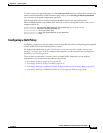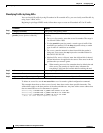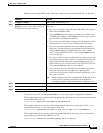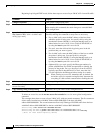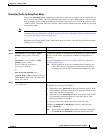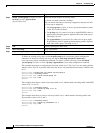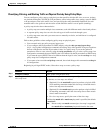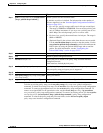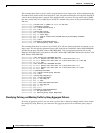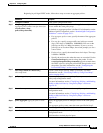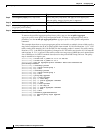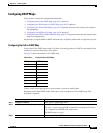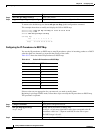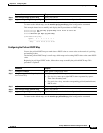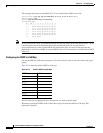
29-47
Catalyst 2960 Switch Software Configuration Guide
78-16881-01
Chapter 29 Configuring QoS
Configuring Standard QoS
To delete an existing policy map, use the no policy-map policy-map-name global configuration
command. To delete an existing class map, use the no class class-map-name policy-map configuration
command. To return to the untrusted state, use the no trust policy-map configuration command. To
remove an assigned DSCP or IP precedence value, use the no set {dscp new-dscp | ip precedence
new-precedence} policy-map configuration command. To remove an existing policer, use the no police
rate-bps burst-byte [exceed-action {drop | policed-dscp-transmit}] policy-map configuration
command. To remove the policy map and port association, use the no service-policy input
policy-map-name interface configuration command.
Step 7
police rate-bps burst-byte [exceed-action
{drop | policed-dscp-transmit}]
Define a policer for the classified traffic.
By default, no policer is defined. For information on the number of
policers supported, see the “Standard QoS Configuration Guidelines”
section on page 29-31.
• For rate-bps, specify average traffic rate in bits per second (bps).
The range is 1000000 to 1000000000. You can set the policing rate
only in 1-Mbps increments. If you try to set a policing rate at less
than1 Mbps, the switch prompts you for a correct value.
• For burst-byte, specify the normal burst size in bytes. The range is
8000 to 1000000.
• (Optional) Specify the action to take when the rates are exceeded.
Use the exceed-action drop keywords to drop the packet. Use the
exceed-action policed-dscp-transmit keywords to mark down the
DSCP value (by using the policed-DSCP map) and to send the
packet. For more information, see the “Configuring the
Policed-DSCP Map” section on page 29-53.
Step 8
exit Return to policy map configuration mode.
Step 9
exit Return to global configuration mode.
Step 10
interface interface-id Specify the port to attach to the policy map, and enter interface
configuration mode.
Valid interfaces include physical ports.
Step 11
service-policy input policy-map-name Specify the policy-map name, and apply it to an ingress port.
Only one policy map per ingress port is supported.
Step 12
end Return to privileged EXEC mode.
Step 13
show policy-map [policy-map-name [class
class-map-name]]
Verify your entries.
Step 14
copy running-config startup-config (Optional) Save your entries in the configuration file.
Command Purpose



